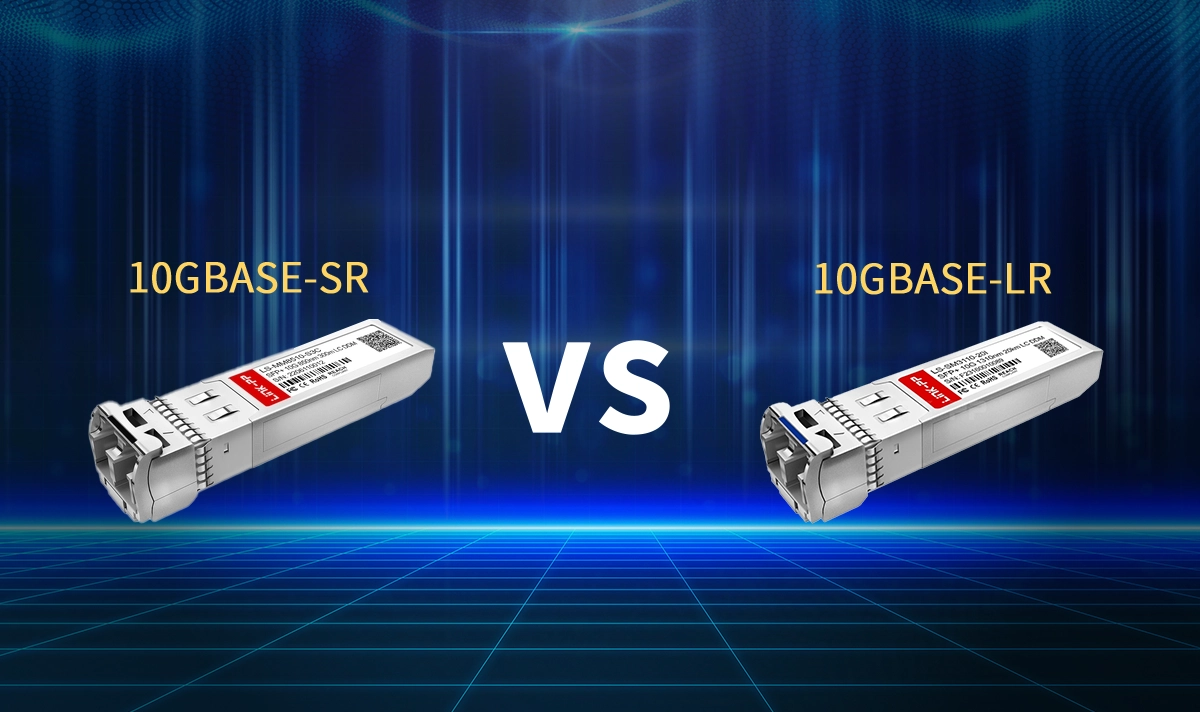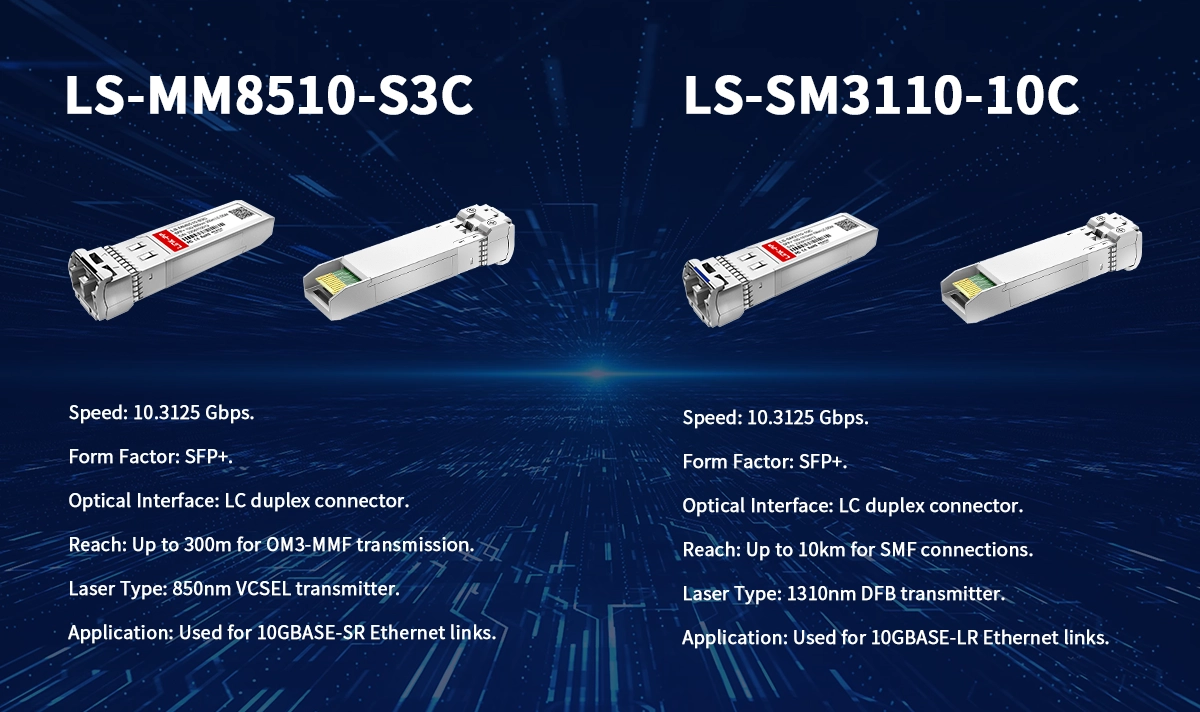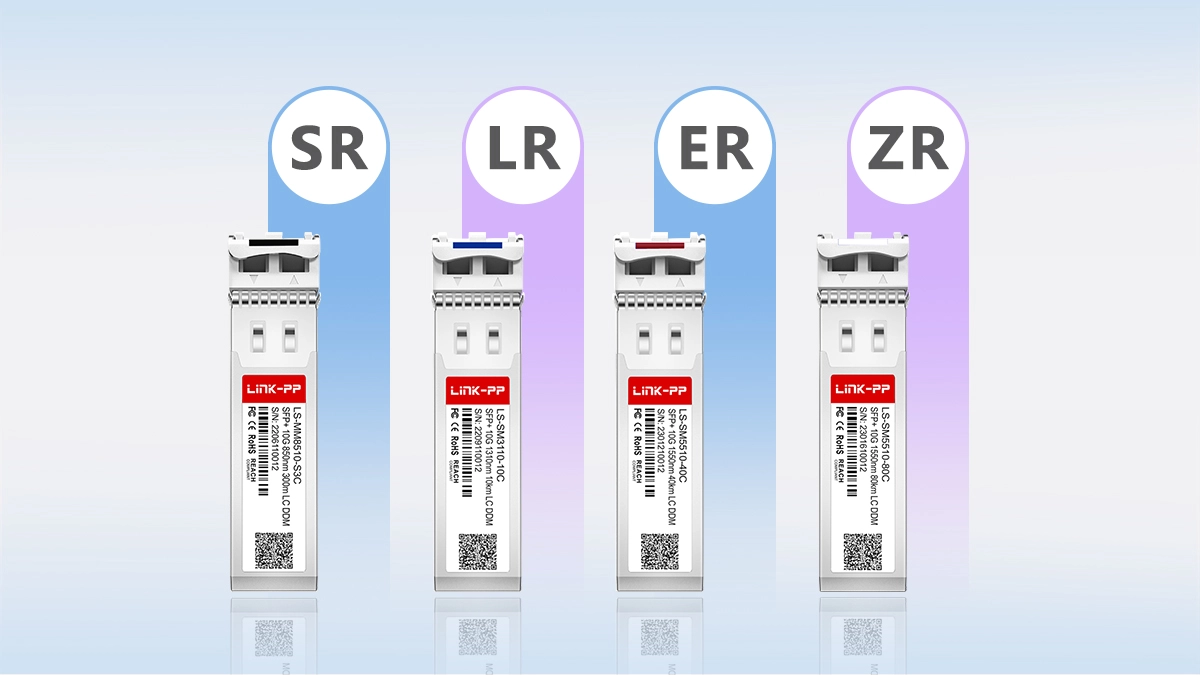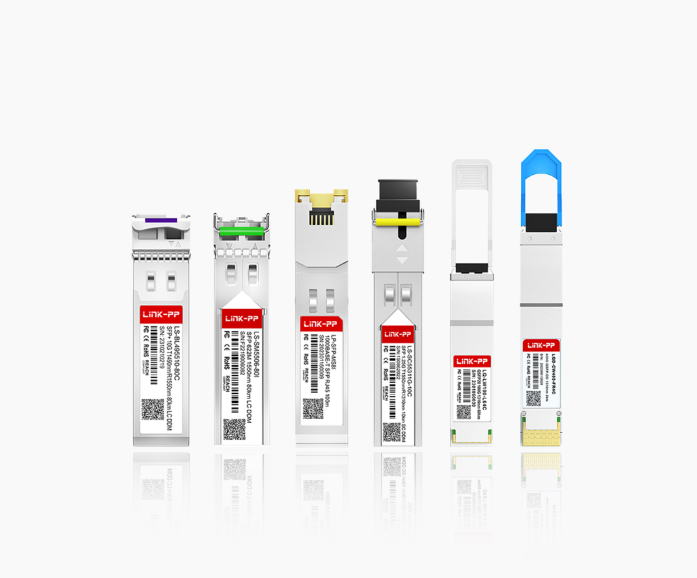
Deploying a 10 Gigabit Ethernet network requires precise component selection, and the choice between SFP-10G-SR and SFP-10G-LR optical transceivers is fundamental. While both are SFP+ form factor modules delivering 10Gbps speeds, their underlying technology, supported distances, and compatible fiber types differ significantly. Selecting the wrong module can lead to network failures, unnecessary costs, or performance bottlenecks. This comprehensive guide dives deep into the SR vs LR debate, empowering you to make the optimal choice for your specific infrastructure, whether it's a high-density data center rack or a campus backbone link. Understanding these differences is crucial for network architects and procurement specialists aiming for cost-effective, reliable, and future-proofed optical connectivity.
✂ Understanding the Core Technologies
SFP-10G-SR (Short Range):
Laser Type: Vertical-Cavity Surface-Emitting Laser (VCSEL)
Wavelength: 850nm
Fiber Type: Multimode Fiber (MMF) - OM3 or OM4 (standard), OM5 (increasingly supported).
Principle: Leverages the larger core diameter of MMF, allowing multiple light paths (modes). VCSELs are cost-effective and lower power.
Key Advantage: Lower cost per module and lower power consumption compared to LR.
SFP-10G-LR (Long Range):
Laser Type: Distributed Feedback (DFB) Laser
Wavelength: 1310nm
Fiber Type: Single-Mode Fiber (SMF) - OS1 or OS2.
Principle: Uses a single, focused light path traveling down the narrow core of SMF. DFB lasers are more precise and powerful than VCSELs.
Key Advantage: Significantly longer reach capabilities over standard SMF.
✂ Head-to-Head Comparison: SFP-10G-SR vs SFP-10G-LR

The table below summarizes the critical differences:
Feature | SFP-10G-SR | SFP-10G-LR |
|---|---|---|
Reach | Up to 300m (OM3), 400m (OM4), 150m (OM5 @ 9536Mbps) | Up to 10km (Standard), some support 20km+ |
Fiber Type | Multimode Fiber (MMF) - OM3, OM4, OM5 | Single-Mode Fiber (SMF) - OS1, OS2 |
Wavelength | 850nm | 1310nm |
Laser Type | VCSEL (Vertical-Cavity Surface-Emitting Laser) | DFB (Distributed Feedback Laser) |
Typical Power Consumption | Lower (~0.5W - 1.0W) | Higher (~1.0W - 1.5W) |
Dominant Cost Factor | Lower Module Cost | Higher Module Cost |
Dominant Fiber Cost | Higher Fiber Cost (per strand/km) | Lower Fiber Cost (per strand/km) |
Primary Use Case | Short reach within racks, rows, data centers | Longer reach between buildings, campuses, MAN |
Key Standard | IEEE 802.3ae 10GBASE-SR | IEEE 802.3ae 10GBASE-LR |
✂ Delving Deeper: Specifications & Applications
Reach & Fiber Compatibility:
10GBASE-SR: Performance is highly dependent on fiber grade. Using OM3? Max ~300m. Upgraded to OM4? Achieve ~400m. OM5 offers similar reach to OM4 for 10G but enables future speed upgrades. Crucially, SR modules cannot work over Single-Mode Fiber. Attempting this results in no link. For reliable SFP+ SR compatibility, pair strictly with OM3/OM4/OM5 MMF. Modules like the LINK-PP SFP-10G-SR are rigorously tested across these MMF types.
10GBASE-LR: Designed for the long haul. Achieves up to 10km over standard OS2 SMF. While technically emitting light compatible with MMF, connecting an LR module to MMF will not achieve its specified distance and is strongly discouraged due to potential modal dispersion issues and unpredictable performance. It will only perform optimally over SMF. LINK-PP SFP-10G-LR modules guarantee 10km performance over OS2 SMF.
Cost Considerations (TCO):
Module Cost: SFP-10G-SR modules are generally less expensive than SFP-10G-LR modules due to the simpler VCSEL technology.
Fiber Cost: This is where the equation flips. MMF (OM3/OM4/OM5) costs significantly more per meter than SMF (OS2). For short runs within a data center, the lower SR module cost often wins out. For longer runs (e.g., > 100-200m), the dramatically lower cost of SMF cable, despite the higher LR module cost, usually results in a lower Total Cost of Ownership (TCO) for an LR-based link. Consider cable costs when planning your 10G optical transceiver deployment.
Power Consumption & Heat:
VCSELs in SR modules are inherently more power-efficient than the DFB lasers used in LR modules. This translates to lower operational costs and reduced heat load within densely packed switches and chassis, a critical factor in large-scale data center deployments using numerous SFP+ modules.
Applications: When to Use Which Module?
Choose SFP-10G-SR If:
Your links are ≤ 400 meters.
You are connecting devices within the same rack, adjacent racks, or within a single data hall.
Your existing cabling infrastructure is Multimode Fiber (OM3/OM4/OM5).
Your priority is minimizing module cost for short links.
You need lower power consumption per port.
Choose SFP-10G-LR If:
Your links are > 400 meters and up to 10km (or beyond with specific modules).
You are connecting devices between different buildings on a campus or across a Metropolitan Area Network (MAN).
Your existing or planned cabling infrastructure is Single-Mode Fiber (OS1/OS2).
You prioritize future-proofing (SMF supports 25G, 40G, 100G, 400G and beyond over much longer distances than MMF can support).
You need maximum reach flexibility on a single fiber type (SMF).
Total Cost of Ownership (TCO) for medium-long runs favors SMF cable + LR modules over MMF cable + SR modules.
✂ Compatibility & Interoperability
Both SR and LR modules adhere to the SFP+ Multi-Source Agreement (MSA) standards, ensuring mechanical and electrical compatibility with SFP+ ports on switches, routers, servers, and NICs from major vendors (Cisco, Juniper, Arista, HPE, Dell, Mellanox, Huawei etc.).
Crucially, SR and LR modules are NOT interoperable with each other over the same fiber type. An SR module (850nm) cannot communicate with an LR module (1310nm). Both ends of a link must use the same technology (SR-SR or LR-LR) and be connected to the correct fiber type (MMF for SR, SMF for LR).
Digital Diagnostics Monitoring (DDM/DOM): Both SR and LR modules typically support DDM/DOM, providing real-time monitoring of parameters like temperature, voltage, TX bias current, TX power, and RX power. This is essential for proactive network monitoring and troubleshooting. Ensure your chosen SFP+ module, like those from LINK-PP, offers reliable DDM data.
✂ The LINK-PP Advantage for Your 10G Needs

LINK-PP delivers high-performance, MSA-compliant SFP+ optical modules engineered for reliability and seamless integration. Our modules undergo rigorous testing to ensure compatibility with major networking equipment and adherence to IEEE standards.
Recommended LINK-PP Models:
For Short-Range MMF Applications: LINK-PP SFP-10G-SR (Compatible with OM3/OM4/OM5, up to 400m)
For Long-Range SMF Applications: LINK-PP SFP-10G-LR (10km over OS2 SMF)
LINK-PP transceivers offer a cost-effective alternative to OEM modules without compromising on quality or performance, backed by solid warranties and expert support. Ensure optimal fiber optic module performance and longevity by choosing trusted brands.
✂ Conclusion: Making the Informed Choice
The decision between SFP-10G-SR and SFP-10G-LR isn't about which module is "better" universally, but about which is optimal for your specific network requirement. Let distance and existing fiber infrastructure be your primary guides:
Short Distances (≤400m) + MMF Cabling = SFP-10G-SR: Cost-effective, lower power, ideal for intra-data center links.
Medium-Long Distances (400m to 10km+) + SMF Cabling = SFP-10G-LR: Essential for extended reach, future-proofing, and often lower TCO over longer cable pulls.
Investing in the correct 10G transceiver module upfront prevents costly link failures, performance issues, and unnecessary rework. Evaluate your link lengths, audit your fiber plant (type and condition), and consider future scalability needs.
Ready to Optimize Your 10G Network?
Choosing the right SFP+ transceiver is critical for performance and cost. LINK-PP offers a wide range of reliable, high-compatibility SFP-10G-SR and SFP-10G-LR modules at competitive prices.
Visit our SFP+ Transceiver Collection Today to Find Your Perfect Match and Experience the LINK-PP Difference in Quality and Value!
✂ FAQ: SFP-10G-SR vs SFP-10G-LR
Q1: Can I use an SFP-10G-SR module over Single-Mode Fiber?
A: No. SFP-10G-SR modules are designed only for Multimode Fiber (OM3, OM4, OM5). They will not establish a link over Single-Mode Fiber. Attempting this is incompatible.
Q2: Can I use an SFP-10G-LR module over Multimode Fiber?
A: While it might sometimes "work" for very short distances (a few meters), it is strongly discouraged and not supported. Performance will be unpredictable and unreliable, and it will not achieve anywhere near the 10km distance. LR modules require Single-Mode Fiber (OS1/OS2) for standard operation.
Q3: What does "SR" and "LR" stand for?
A: SR stands for "Short Range". LR stands for "Long Range". These designations are defined within the IEEE 802.3ae standard for 10 Gigabit Ethernet.
Q4: What is the maximum distance for SFP-10G-SR?
A: It depends on the fiber grade:
Up to 300 meters over OM3 Multimode Fiber.
Up to 400 meters over OM4 Multimode Fiber.
Up to 150 meters over OM5 Multimode Fiber (when operating at the full 10.3125 Gbps line rate specified by 10GBASE-SR). OM5 is optimized for SWDM, not necessarily for extending 850nm VCSEL reach beyond OM4.
Q5: What is the maximum distance for SFP-10G-LR?
A: The standard reach for SFP-10G-LR modules is up to 10 kilometers over OS2 Single-Mode Fiber. Some vendors offer "ER" or "ZR" variants supporting 40km or 80km, but standard LR is 10km.
Q6: Are SFP-10G-SR and SFP-10G-LR modules compatible with my Cisco/Juniper/HPE switch?
A: MSA-compliant modules like those from LINK-PP are designed for broad compatibility. However, some OEMs implement firmware locks. Always check the vendor's compatibility list or choose manufacturers like LINK-PP known for robust multi-vendor interoperability testing. Using third-party optics like LINK-PP offers significant cost savings.
✂ See Also
A Simple Guide to SFP-10G-SR and Its Practical Uses




